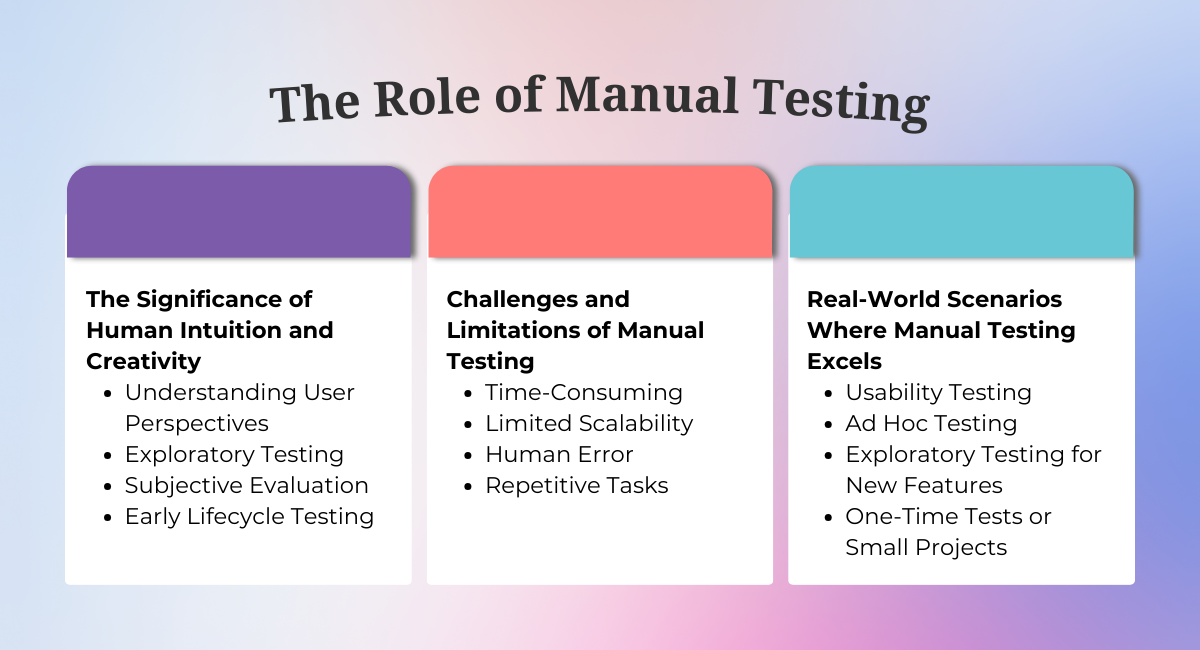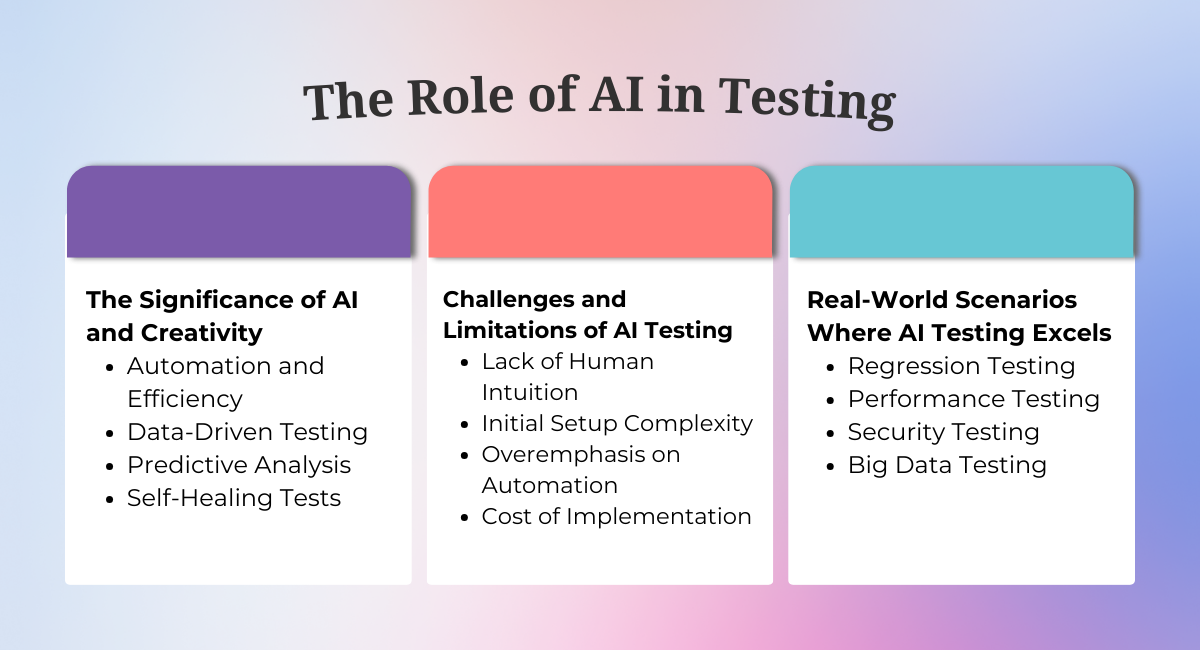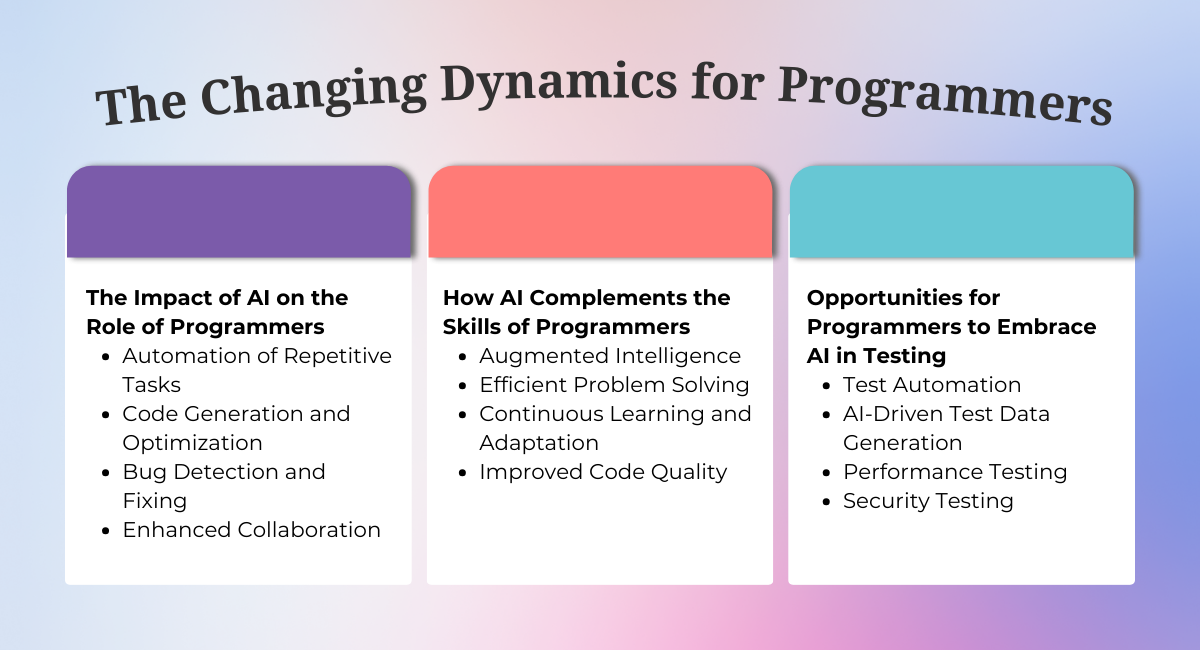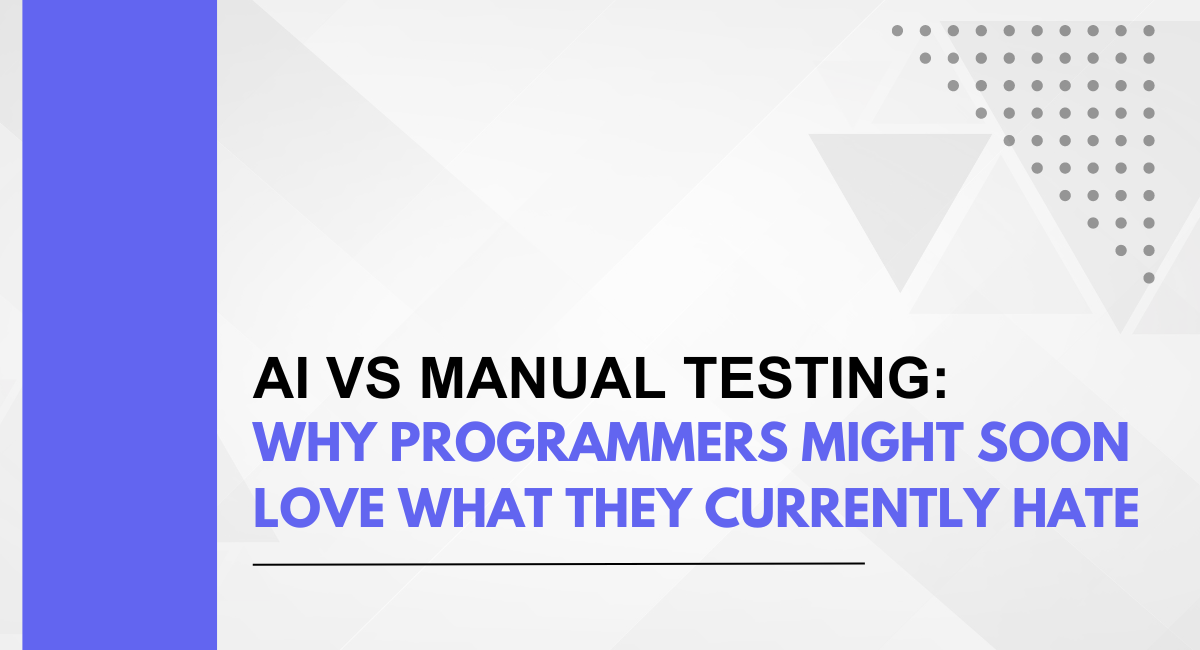Software testing is a crucial phase in the software development life cycle (SDLC) that ensures a software product's quality, functionality, and reliability. It involves the execution of a program or system with the intent of finding errors, verifying that the software meets specified requirements, and ensuring its overall performance. Read the AI vs Manual Testing blog to get insights.
Testing can be performed at various levels of the SDLC, including unit testing, integration testing, system testing, and acceptance testing. Each level of testing focuses on specific aspects of the software, contributing to the overall quality assurance process.
The Role of Manual Testing

A. The Significance of Human Intuition and Creativity
- Understanding User Perspectives: Human testers bring a unique ability to understand user perspectives, enabling them to identify usability issues, design flaws, and areas of improvement that may go unnoticed in automated testing.
- Exploratory Testing: Manual testing allows for exploratory testing, where testers can dynamically explore the application, simulate real-world scenarios, and uncover unexpected issues. This flexibility is valuable, especially in complex and evolving software projects.
- Subjective Evaluation: Human testers can provide subjective evaluations of the user experience, offering insights into the "feel" of the software. This is crucial for applications where user satisfaction and engagement are paramount.
- Early Lifecycle Testing: Manual testing is often employed in the early stages of development when requirements are evolving. Testers can use their intuition to identify potential issues and provide valuable feedback for refining requirements.
B. Challenges and Limitations of Manual Testing
- Time-Consuming: Manual testing can be time-consuming, especially for repetitive and extensive test cases. This can lead to delays in the software development lifecycle, making it challenging to keep up with the rapid pace of agile and DevOps practices.
- Limited Scalability: Manual testing is not easily scalable, making it challenging to handle large-scale testing efforts or regression testing in projects with frequent code changes.
- Human Error: Manual testing is susceptible to human error, such as oversight or misinterpreting requirements. This can result in undetected defects and impact the overall quality of the software.
- Repetitive Tasks: Testers may find performing repetitive tasks monotonous, leading to fatigue and a higher likelihood of overlooking defects.
C. Real-World Scenarios Where Manual Testing Excels
- Usability Testing: Manual testing is essential for evaluating the user interface, user experience, and overall software usability. Testers can assess how easily users can navigate the application and identify design issues.
- Ad Hoc Testing: In scenarios where requirements are not clearly defined or are subject to change, manual testing allows testers to perform ad hoc testing, exploring the application in an unplanned manner to uncover defects.
- Exploratory Testing for New Features: When new features are introduced, manual testing effectively explores and validates these features' functionality. Testers can creatively simulate real-world scenarios to ensure the robustness of new functionalities.
- One-Time Tests or Small Projects: The overhead of developing automated scripts may outweigh the benefits of small projects or past tests. Manual testing is a cost-effective and efficient approach in such cases.
The Role of AI in Testing

A. The Significance of AI and Creativity
- Automation and Efficiency: AI in testing brings automation to repetitive and time-consuming tasks, allowing testers to focus on more creative and complex aspects of testing. This automation contributes to faster test execution, increased test coverage, and quicker feedback loops.
- Data-Driven Testing: AI leverages data analytics and machine learning to analyze vast amounts of data, enabling intelligent decision-making in testing. It can identify patterns, anomalies, and trends in test results, helping testers make informed decisions about the quality of the software.
- Predictive Analysis: AI algorithms can predict potential areas of failure based on historical data, helping prioritize testing efforts and focus on high-risk areas. This predictive capability enhances testing efficiency and reduces the likelihood of critical defects reaching production.
- Self-Healing Tests: AI can facilitate self-healing tests by automatically updating test scripts to adapt to changes in the application. This reduces the maintenance overhead of evolving software and ensures that tests remain relevant over time.
B. Challenges and Limitations of AI Testing
- Lack of Human Intuition: AI lacks the human intuition and qualitative understanding that human testers bring to the testing process. While AI excels in repetitive and data-driven tasks, it may struggle to comprehend complex, subjective, or evolving requirements.
- Initial Setup Complexity: Implementing AI testing solutions requires significant initial setup and training of algorithms. Organizations may face challenges integrating AI into existing testing processes, especially legacy systems.
- Overemphasis on Automation: Relying solely on AI for testing can lead to neglecting certain aspects that require a human touch, such as usability testing, exploratory testing, and subjective assessments of the user experience.
- Cost of Implementation: Implementing AI testing solutions may involve substantial upfront costs, including acquiring AI tools, training personnel, and integrating existing testing infrastructure.
C. Real-World Scenarios Where AI Testing Excels
- Regression Testing: AI excels in performing regression testing, especially in projects with frequent code changes. It can quickly execute many test cases to ensure new changes do not introduce unintended side effects or regressions.
- Performance Testing: AI can simulate many virtual users, helping in performance testing scenarios to identify bottlenecks, analyze system behaviour under load, and optimize software performance.
- Security Testing: AI effectively identifies security vulnerabilities and code patterns that may indicate potential security risks. It can analyze code for known security threats and help in the early detection of vulnerabilities.
- Big Data Testing: In projects dealing with large volumes of data, AI can analyze and validate data integrity, ensuring that the application functions correctly under various data conditions.
The Changing Dynamics for Programmers

A. The Impact of AI on the Role of Programmers
- Automation of Repetitive Tasks: AI profoundly impacts the role of programmers by automating repetitive and mundane coding tasks. This allows programmers to focus on more complex and creative aspects of software development, leading to increased productivity and innovation.
- Code Generation and Optimization: AI tools can generate code snippets, assist in code completion, and optimize code for better performance. Programmers can leverage these tools to streamline their coding process and produce more efficient and reliable software.
- Bug Detection and Fixing: AI-based tools can aid programmers in identifying and fixing bugs in the code. Through static code analysis and machine learning algorithms, AI can analyze patterns in code to detect potential issues, reducing the time and effort required for debugging.
- Enhanced Collaboration: AI-powered collaboration tools assist programmers in working more efficiently with team members. These tools can facilitate code reviews, suggest improvements, and ensure coding standards are met, fostering a more collaborative and streamlined development process.
B. How AI Complements the Skills of Programmers
- Augmented Intelligence: AI complements the skills of programmers by providing augmented intelligence. Programmers can leverage AI tools to enhance decision-making, gain insights from large datasets, and optimize software development processes.
- Efficient Problem Solving: AI algorithms can assist programmers in solving complex problems by analyzing data, identifying patterns, and suggesting optimized solutions. This collaborative approach allows programmers to leverage AI's computational capabilities for more efficient problem-solving.
- Continuous Learning and Adaptation: AI facilitates continuous learning for programmers by recommending best practices, new coding techniques, and emerging technologies. This enables programmers to stay updated with the latest trends in software development.
- Improved Code Quality: AI tools can enhance code quality by enforcing coding standards, identifying potential vulnerabilities, and suggesting optimizations. This results in more robust and secure software applications.
C. Opportunities for Programmers to Embrace AI in Testing
- Test Automation: Programmers can embrace AI in testing by incorporating test automation into their workflows. AI-based testing tools can automate repetitive test cases, allowing programmers to focus on designing and implementing more complex and critical tests.
- AI-Driven Test Data Generation: Programmers can utilize AI to generate realistic and diverse test data, ensuring comprehensive test coverage. AI algorithms can analyze application requirements and automatically generate test data that covers various scenarios.
- Performance Testing: AI can assist programmers in performance testing by simulating realistic user loads and analyzing system behaviour under different conditions. This ensures that applications are optimized for performance and can handle varying usage levels.
- Security Testing: Programmers can leverage AI in security testing to identify vulnerabilities and potential threats in the code. AI tools can analyze code for known security patterns and suggest improvements to enhance the overall security posture of the software.
Create Positive Impact - AI vs Manual Testing
Looking ahead, the future holds promise for programmers to find joy in aspects of their work that may be challenging. As AI continues to evolve, it will likely alleviate programmers from mundane and repetitive tasks, allowing them to dedicate more time to creative problem-solving and innovation.
Improved collaboration tools, code optimization suggestions, and AI-driven insights may create a more enjoyable and fulfilling development experience. Programmers can anticipate a future where AI acts as a supportive partner, enhancing their capabilities and positively impacting both the development process and the final product.
You may also be interested in Blog: Insights, Tips & Updates Around Test Automation.
Book a Demo and experience ContextQA testing tool in action with a complimentary, no-obligation session tailored to your business needs.
We make it easy to start with the ContextQA tool: Start Free Trial.
